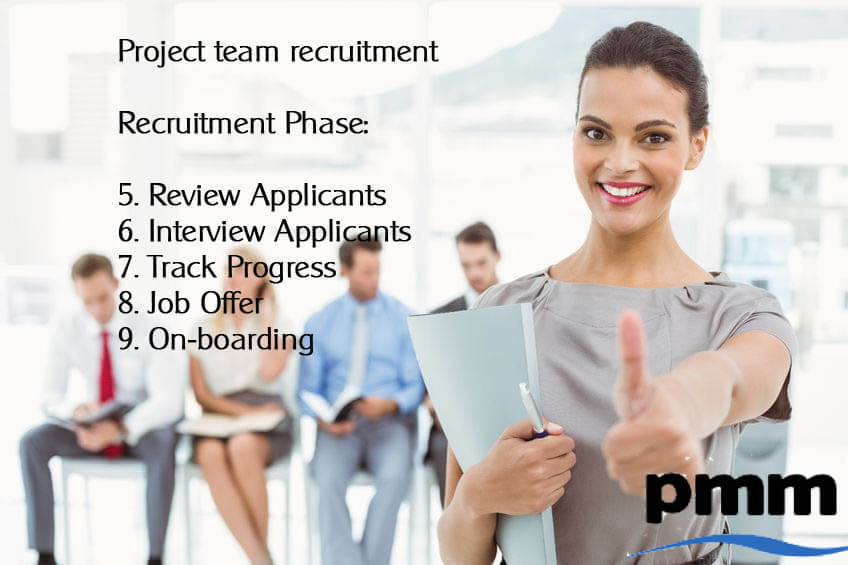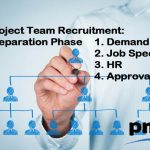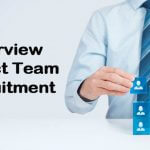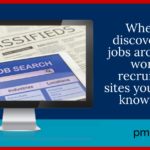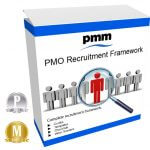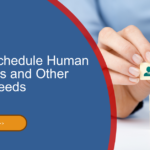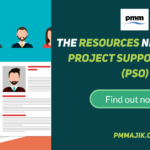In the last post, I cover the Preparation Phase of project team recruitment, this post will cover the steps involved to recruit the project resources.
Recruitment Phase
There are 5 steps within the recruitment phase.
Review Applicants
This is the step of where you review the applications from potential candidates. This will typically be in the form of a CV and possibly a cover letter.
IMPORTANT: People are the most important asset to delivering a project. Therefore, you need to select and on-board them as quickly as you can. The reason I reiterate this point is too many hiring managers never put the time and effort into reviewing CV’s. because they are too busy.
It is the smart hiring manager that realises that the most important task in their inbox is hiring the resources they need. They know this is the path to gaining more time in their day as the workload can be distributed.
So, if you want to set yourself apart from others, place the correct focus on reviewing the CV’s.
A very good method is to make a committment to yourself and, even better, HR, Recrutiment Agents, etc, that you will review all CV’s within 48 hours of receiving them. If you are responsive, you will get a better service from HR and agents.
If you are recruiting a number of CV’s, or for many roles, you need a method to quickly select CV’s into 3 categories:
- Yes – 1st round interview
- No – not suitable
- Maybe – those where you are not sure but something has caught your eye
There are different methods to do this and the more you recruit, the better you will be at doing this quickly. However, some good principles are to scan for key pointers:
- Check for appropriate skill
- Check for appropriate experience
- Check for regular breaks in employment / short duration in role
- Academic / Professional qualifications
If you have built a good relationship with HR, they can apply some of these filters to eliminate CV’s before they reach you.
It is a good idea to have a checklist of the key points to help drive the process and ensure consistency.
At the end of this step you should have 3 piles of CV’s (paper or electronic).
Those in the “Yes” pile, ask HR to arrange the interviews as quickly as they can. Advise HR of the “No’s”. This is being a good person as I am sure that like me, you have applied for a role and never been told that they do not want to interview.
You can then revisit the “Maybe’s” to see if any move to “Yes”. The remainder you can keep in reserve while you complete the 1st round interviews.
Interview Applicants
It is important to prepare and be in the right frame of mind when you interview.
Ensure that you read the CV ahead of the interview and highlight areas you wish to expand on in the interview. You also should check that a meeting room is booked.
It is a good idea to spend the first 5 minutes giving an overview to the organisation, the area and the role. When you have done this allow the candidate to ask questions to clarify. Remember, this is your opportunity to sell the role to the candidate. You need to remember that good candidates will be in demand from other organisations.
Then ask them to take you through their CV highlighting the relevant experience and, most importantly, how they can help you with your challenges. This will demonstrate if they understand what you are looking for and if they have the real experience you need.
This should then lead to a nice flow of conversation allowing you to dig deeper on the items you highlighted when you reviewed the CV.
You should also ensure that you follow any process mandated by your organisation. This should have been identified in the HR Engagement step. For example, there may be a set format to the interview with certain questions you must ask and a template to capture responses. If there is a set process make sure you follow it and submit all paperwork in a timely manner.
When you have completed the 1st round interviews, hopefully you will have identified some strong candidates for the 2nd round. Again make sure that you ask HR to set these up with the appropriate person. The same applies for any subsequent round depending on the number of interviews in the process.
Make sure you provide feedback to HR of those who will not be progressed in a timely manner. This is a good way to treat people. Even though they will not be happy for not making the next round, they will appreciate that they received constructive feedback they can learn from.
Track Interview Progress
With so much going on, it is important to track progress of the candidates and interviews. This will help you remain focused and capture important points.
If there is a tool you have to use for this process, even better. If not you can use a simple spreadsheet with role, candidate, interview date, progress to next round, brief notes. This can then be used as a method to provide the positive and constructive feedback to the candidates via HR, to let HR know who to set up 2nd round interviews and, to share with other hiring managers where there are some good candidates but they are not right for your role.
Job Offer
When all of the interview process is over and you have selected your candidate, work with HR to ensure that the feedback is given quickly and advise that an offer will be made. This will keep the candidate interested while the offer is put together and approved.
Make sure that the package details are discussed early to ensure that there is alignment. There is nothing worse than the offer being issued only to find it is substantially different to the expectation. If it is close, you want to reach agreement before it is issued as it is difficult to change once the offer is formally issued.
Check in regularly with HR to make sure that they maintain contact with the candidate to help ensure they accept. Leaving a long gap can lead to the candidate to go cold and then not accept. This is not ideal after you have invested so much time in the process.
On-boarding Activities
With the offer accepted you can start planning for the on-boarding. This is wise as system set-up, passes, etc can take time. The quicker you get the appropriate requests into the process the better. This allows any issues to be resolved ahead of the start date. The last thing you want is to risk the candidate having a bad experience on day 1, first impressions count.
Keep engaged with HR to ensure you know the start date and that you are prepared. You want to have space in your diary to welcome the new recruit.
You should also consider putting together an induction pack. You can find details in the post “PMO Induction Process Overview“.
Summary
This post has covered a lot of ground. It is important to have the correct focus at every step to ensure that you recruit the best candidates in the optimal time. Following the steps in this post should give the structure and focus you need.
